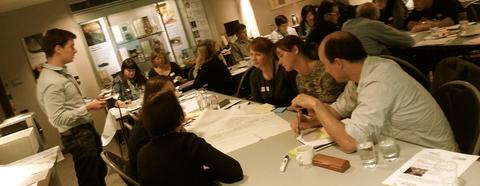A blog by Cameron Crawley, Curatorial Assistant (work placement) for South American Fossil Mammals at the Natural History Museum, reporting on a Collections for All workshop at the Hunterian Museum at the Royal College of Surgeons: Encouraging clinical research in natural science collections.

Cameron Crawley, Curatorial Assistant (work experience) participating in a workshop activity (on the left).
Clinical research in natural science collections is evolving, as it continues to serve a dual purpose that balances financial pragmatism and visitor education. Whereas museum professionals and institutions traditionally took a compartmentalised approach to research practices in their collections, cross-professional engagement is proving essential to further cutting edge clinical research today. Certainly, without the benefits this research brings, our collections would find it challenging to pay bills and engage the public.
This was the crux of the discussion at the workshop on encouraging research in natural science collections graciously hosted by the Hunterian Museum at the Royal College of Surgeons on 17 June 2014 . Attendee institutions included the:
- Hunterian Museum
- Natural History Museum
- Horniman Museum and Gardens
- Museum of London
- Grant Museum of Zoology, University College London
- Kings College London
- University of Nairobi Faculty of Medicine.
As such, this meeting is a perfect example of the cross-professional exchange that is necessary for furthering research in our collections.
Workshop activities
Delegates participated in panel discussions and group activities to engage with a variety of topics surrounding the area of clinical research in natural science collections. Subjects ranged from safeguarding the benefits of clinical research to sharing the unique characteristics of collections from the institutions represented at the event.
The crux of the day was to encourage new ideas for enhancing and preserving the clinical research that occurs in natural science collections. Throughout the various panels and group activities three key objectives were discussed repeatedly by those in attendance:
- facilitating cross-professional connections
- increased discourse
- clinical research practices
Facilitating cross-professional connections
This first objective involves establishing and maintaining connections with professions outside of the museum sphere. Whether this involves conferences with veterinary practitioners, or greater collaboration with university museum studies and training programs, there was a broad consensus that more networking is needed. Perhaps more importantly, once a professional network has been created, it needs to be maintained; networks form an integral part of institutional memory.
Increased discourse
The second objective naturally builds from the need for greater sustained networking. The workshop demonstrated a greater need for discourse within the museum profession. Several attendees noted that although such conferences are invaluable for sharing and exploring new opportunities, they are few and far between.
To counteract this trend, there has to be a follow-up mechanism for all involved to ensure that networks are maintained and that concepts and ideas are implemented.
Clinical research practices
The final objective involves consolidating current successes for the future of clinical research. As institutions, museums have expertise in preserving specimens and providing access to researchers. Several case studies were used throughout the day to illustrate what is being done to further clinical research across multiple institutions.
One such project includes the Gorilla Pathology Study Group headed by Professor John E Cooper, Consultant Veterinary Pathologist. The study group seeks to examine gorilla material as part of a collaborative study of skeletal and dental pathology in order to understand and promote the health and welfare of gorillas in the wild. Through this endeavour, the Hunterian Museum has used professional networking to entice veterinary surgeons to bring their expertise to the collection.
This programme has had reciprocal positive effects on its participants. The Hunterian Museum benefits from the expertise of these professionals, especially with regards to analysing or imaging specimens. Moreover, vets working within the study group have benefited through access to the extensive collection of material at the Hunterian Museum. A summing up panel concluded that these kinds of relationships can only improve the quality of the clinical research performed at the institutions present.
This conference showed all in attendance that establishing and sustaining networks outside of our professions is critical for creating future success stories. However it is also worth noting that these are not the only benefits that museums enjoy due to clinical research. What other benefits do you believe clinical research brings into your museum or institution?
Add new comment